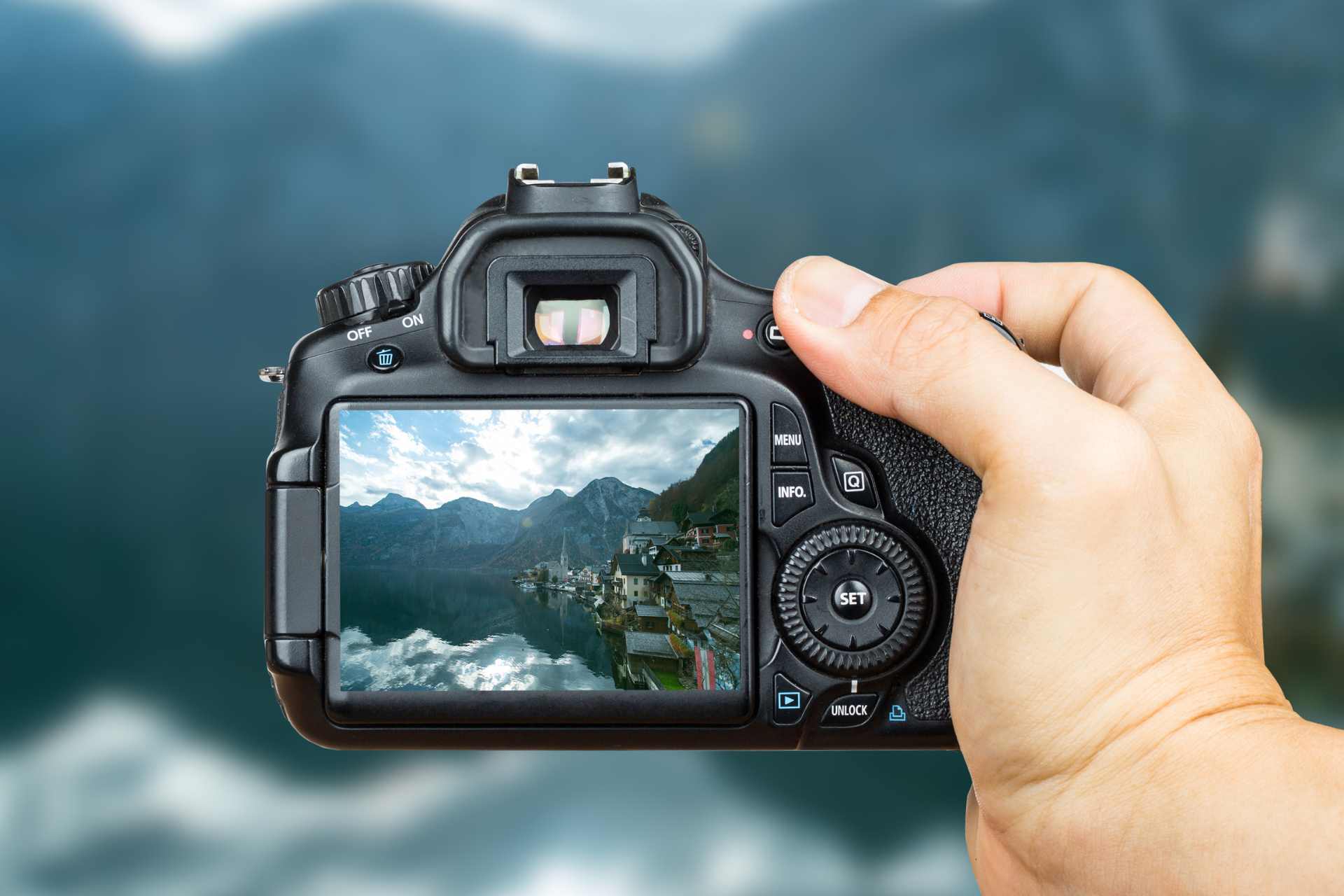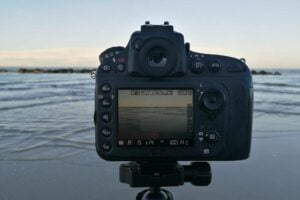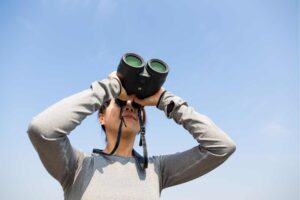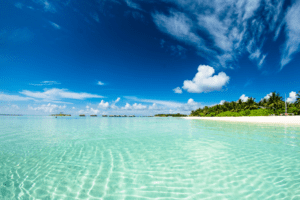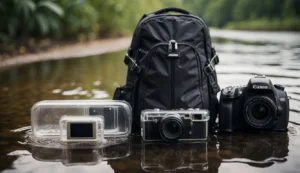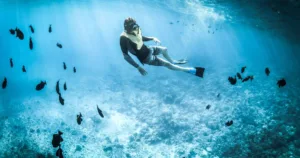Best Camera for Whale Photography: Top Picks for Stunning Marine Shots
Photography equipment has to meet the demands of the conditions in which it’s used, and that is particularly true when the subject is as dynamic as whales in their natural habitat. Capturing these magnificent marine mammals requires a camera that can handle the unique challenges of both wildlife and underwater photography. This means a camera setup with features such as high-speed autofocus, robust build to endure the marine environment, and excellent image quality to catch the fine detail of these ocean giants.
When selecting the best camera for whale photography, one must consider factors like whether to prioritize full-frame sensors for better image quality or if a crop sensor’s extended reach is more beneficial given the subjects’ often-distanced nature. Additionally, the speed of continuous shooting mode is crucial to taking multiple shots of a breaching whale or a swiftly moving pod. Cameras must also have high ISO capabilities for dealing with the often dim lighting of overcast days at sea or underwater scenarios. Durability in terms of weather sealing is a must since salt water and humidity present a persistent threat to camera gear.
When preparing to buy a camera for photography of whales, size, weight, and ease of handling can’t be overlooked either. Larger cameras might offer more features, but a heavy and bulky camera can become a liability in the confines of a whale-watching boat or during a lengthy swim. Furthermore, the lens choice is as critical as the camera body; a good telephoto lens is indispensable for capturing detailed images from a distance, while reliable underwater housing is essential for subaquatic shots.
The right camera can distinguish between a missed opportunity and a timeless whale image in its natural environment. Whether you’re a hobbyist aiming to document these creatures from a respectful distance or a professional seeking to add breathtaking whale photos to your portfolio, understanding the significance of these features is the first step towards capturing remarkable marine life photography. Next, we’ll look at specific camera models that can help you achieve your whale photography goals, examining their respective strengths and features to make the best purchase decision.
Top Cameras for Whale Photography
Capturing the majesty of whales in their natural habitat requires a camera that excels in both performance and durability. As you embark on your quest to photograph these magnificent creatures, you’ll need equipment that can handle the demands of marine photography. The following list has been curated to present you with cameras offering robust waterproofing, high image quality, and powerful zoom capabilities, ensuring you can document every breathtaking moment with clarity and precision.
Monitech 4K Vlogging Camera


If you’re diving into the world of whale photography, this camera offers a balance of portability and power that will capture the majesty of these ocean giants.
Pros
- Fantastic for travel with dual batteries and a 32GB TF card included
- Equipped with a wide-angle and macro lens for versatile shooting
- 180° flip screen ideal for varied angle shots and vlogging
Cons
- Learning curve with lens swapping
- Some reported grainy picture quality
- Limited to digital zoom rather than optical
Capturing the breathtaking spectacle of whales requires a blend of patience and the right equipment. The Monitech 4K Vlogging Camera meets these needs with its high-resolution capabilities, ensuring each colossal breach or serene glide beneath the waves is captured in stunning detail. The wide-angle lens is particularly beneficial when attempting to encompass the vastness of the ocean and its majestic inhabitants in a single frame.
When on the go, continuously searching for that perfect whale shot, having two batteries becomes a lifesaver, especially in remote locations where charging is not an option. The memories don’t need to stop when the sun sets; nighttime shots appear vivid with the camera’s decent performance in lower light settings, preserving the atmosphere of moonlit seascapes.
Understanding the nuances of this camera’s features, such as when to utilize the macro lens for detailed close-ups of marine flora or the textured patterns of whale skin, becomes an enjoyable part of the learning process. You’ll appreciate the user-friendly setup that makes it easy to adjust settings or switch to video mode, capturing not just stills but also the majestic movements and sounds of marine life.
Duluvulu 4K Vlogging Camera


If you’re keen on capturing the majestic beauty of whales in their natural habitat, this camera will help immortalize those moments in stunning clarity.
Pros
- Reliable autofocus for sharp images
- Handy flip screen for versatile shooting angles
- Webcam functionality extends its use beyond photography
Cons
- Limited to digital zoom
- Might not be suitable for professional quality demands
- Battery life may need monitoring for extensive shoots
Having just returned from a thrilling whale-watching excursion, I can attest to the Duluvulu 4K Vlogging Camera’s prowess in wildlife photography. The autofocus is a game-changer; it works swiftly, locking onto moving subjects with precision, which is absolutely crucial when you’re trying to photograph something as unpredictable as whales breaching.
The flip screen offered me flexibility when shooting from the cramped confines of the boat, helping me snag some otherwise tricky angles. Selfies with the ocean giants in the backdrop turned out to be incredibly immersive, with the camera ensuring every snapshot was Instagram-ready.
Another aspect that saved the day was its webcam capabilities. I had the opportunity to livestream parts of the voyage to friends and followers, sharing the excitement in real time. The quality of the video as a webcam was more than adequate, making it a versatile travel companion.
On the downside, the reliance on digital zoom rather than optical means distant subjects lack the crispness found in closer compositions. Professional photographers might find the image quality doesn’t always meet their rigorous standards. Also noteworthy is that I kept a keen eye on battery levels during extended shooting periods, although having two batteries did help mitigate any power concerns.
In sum, the Duluvulu 4K Vlogging Camera has proven itself to be a worthy tool for capturing the majesty of whales. It stands out with user-friendly features like autofocus and a versatile screen while also doubling as a capable webcam. It may not be the choice for everyone, particularly professionals seeking the highest quality, but it’s a valuable asset for enthusiasts and hobbyists.
Zheozeig 5K Vlogging Wonder


You’ll be captivated by the crisp, vibrant images this camera delivers, perfect for bringing the majesty of whales into focus.
Pros
- Effortless, sharp autofocus sharpens whale shots on the move
- Feature-packed with time-lapse and slow-motion capabilities
- Travel-friendly thanks to its compact, stylish design
Cons
- Can be overwhelming, with too many features for beginners
- Limited low-light performance without using the built-in flash
- Some may prefer a larger screen for a clear preview
Holding the Zheozeig 5K Vlogging Camera in your hands, the first thing that strikes you is its stylish retro design. It’s not just about looks, though; the camera feels ready for action, exceptionally light, and well-balanced, making it a practical companion for day-long whale-watching trips.
The autofocus is a game-changer; it locks onto fast-moving whales with surprising agility. The crisp images almost jump out of the frame, each detail from the barnacles on a whale’s nose to the spray of ocean water in sharp relief. While maneuvering on a bobbing boat, the gyroscopic stabilization helps keep your shots steady, a feature you’ll appreciate after a day on the water.
Switching between modes is no hassle, just a twist of the dial. It’s the kind of no-fuss operation you require when every second counts before a whale breaches. For those who love to play with settings, the plethora of modes, from time-lapse to slow-motion, adds creativity to your oceanic endeavors. Just watching the sun dip below the horizon in a time-lapse captured by this camera is an experience in itself.
But every camera has its drawbacks. For instance, you might find the multitude of features a bit intimidating if you prefer a simple point-and-shoot. And if you’re shooting in the dim light of dawn or dusk, you may need to rely on the built-in flash for clarity, as low-light shots without it don’t do justice to this camera’s potential. The 2.8-inch display is crisp, yet some users might desire a larger screen for better previewing their aquatic subjects.
In sum, if you’re seeking a compact camera ready to tackle the vast ocean and its inhabitants with ease, the Zheozeig 5K Vlogging Camera, with its robust feature set and convenient size, is a choice worthy of consideration.
Bifevsr Travel Cam


You’ll find this compact yet feature-rich camera to be a reliable companion for capturing the majesty of whales in their natural habitat.
Pros
- Extremely lightweight and portable, making it perfect for long boat trips
- Built-in flash allows for clear photographs even in low-light conditions at sea
- Simple controls and autofocus features cater to both beginners and seasoned photographers
Cons
- The auto-stabilization could be better when dealing with the motion of waves
- While compact, its build might not be as robust as needed for harsh marine environments
- Battery life can be limiting for extended photography sessions without a recharge
Imagine yourself on the deck, salt air bracing against your face as you scan the horizon for the tell-tale spout of a whale. With the Bifevsr 4K Digital Camera in hand, you’re poised to capture every thrilling moment. Its lightweight design won’t weigh you down as you pivot and aim, the autofocus snapping to clarity just as a humpback breaches spectacularly.
Even as the sunlight begins to wane, the camera’s flash shines through the gathering gloom, illuminating the subtle tones of the whale’s skin against the darkening ocean. Multi-functional capabilities such as slow motion and time-lapse open a vista of creative possibilities – imagine capturing the slow, graceful arc of a whale’s dive in fine detail.
Yet, no product is without its trade-offs. You might need steadier hands in the heaving swell as the surging waves challenge the camera’s anti-shake. The durability also crosses your mind – a protective case might be a wise investment for the salty sprays. A spare battery would be handy after a few hours of continuous use, so you don’t miss any opportunity while waiting for a charge.
Overall, the Bifevsr Travel Cam is a capable tool for aspiring or proficient marine photographers. Despite a few shortcomings, it offers vivid imagery and a user-friendly experience, which makes it worth consideration.
Lumix FZ300


If you’re keen on capturing the grandeur of whales in their natural habitat, the Lumix FZ300 is a reliable companion, adept in both stills and video.
Pros
- Exceptional zoom capability with a constant F2.8 aperture, ensuring bright images
- Robust construction stands up to the elements, perfect for unpredictable ocean environments
- Advanced 4K photo function grabs high-resolution pictures from video footage
Cons
- Limited by a smaller sensor size, it is challenging in very low light conditions
- A heavier build might not suit those preferring an ultra-lightweight option
- Some users may seek higher than 12.1-megapixel images for large-format prints
When you lay hands on the Lumix FZ300, its build quality is immediately apparent; it’s crafted to endure the salt spray and moisture encountered on sea voyages. Its impressive 24x Leica lens, reaching from wide-angle to far-reaching telephoto, captures the majesty of breaching whales without disturbing them. As you pan with the ocean giants, the 5-axis stabilization ensures your footage remains steady, faithfully reproducing the serene ocean scenes.
While out in the open waters, the accessible controls of the FZ300 allow for swift adjustments, mirroring the unpredictable nature of your aquatic subjects. The 4K video feature is more than a gimmick; it’s a valuable tool, snatching crisp images from high-quality video, so you’re always ready for that unexpected breach or tail slap. Even in the dimming light, the camera holds its own, although the smaller sensor reminds you of its limits as dusk falls.
Reviewing your shots back on the boat, the WiFi capability of the FZ300 brings convenience to the forefront. Transferring images to your mobile device, you can quickly share your encounters with the world or revisit your approach for the next outing. Despite its shortcomings in sensor capability and weight, the Lumix FZ300 doesn’t fail to impress with its suite of features tailored to action and wildlife photography.
Buying Guide
Key Features to Consider
Sensor Size and Resolution: You’ll need a camera with a large sensor and high resolution to capture the ocean’s vastness and the whales’ details. Larger sensors generally provide better image quality, especially in low-light conditions.
- Full-Frame Sensors: Ideal for dynamic range and detail.
- Resolution: 20 megapixels or more is recommended for clarity.
Lens Compatibility: A variety of lenses are crucial for whale photography. You’ll require a selection that allows both wide-angle shots and close-ups without disturbing the animals.
- Telephoto Lenses: Essential for taking pictures from a distance.
- Wide-Angle Lenses: Useful for capturing the surroundings and large subjects.
Autofocus System: Look for a camera with a fast and accurate autofocus system. Tracking moving subjects such as whales should be efficient and reliable.
- Points of Focus: More focus points can improve accuracy.
- Speed: A faster autofocus helps in capturing fleeting moments.
Durability and Weather-Sealing: Your camera must withstand marine environments. Weather sealing is a must for protection against sea spray and moisture.
- Build Quality: Durable materials that can handle saltwater exposure.
- Weather-Sealing: Ensures that the camera can cope with wet conditions.
Battery Life: Long battery life is important when spending extended periods at sea where charging options may be limited.
- Battery Capacity: Look for high-capacity batteries or the option to use battery grips for extra power.
Additional Features
Image Stabilization: Helps to reduce camera shake and is valuable when shooting from a moving boat.
- In-body Stabilization: Reduces the need for a tripod and provides flexibility in hand-held shooting scenarios.
Burst Rate: A high burst rate can make the difference in capturing the perfect action shot, enabling multiple shots in rapid succession.
| Feature | Why It Matters |
|---|---|
| Sensor Size | Determines image quality and light-gathering capacity |
| Megapixel Count | Affects image resolution and detail |
| Lens Availability | Versatility in capturing various shots |
| Autofocus Speed | Critical for moving objects |
| Durability | Must survive harsh conditions |
| Battery Life | Longer periods of uninterrupted shooting |
| Image Stabilization | Minimizes blurriness in rough seas |
| Burst Rate | Captures fleeting moments |
By prioritizing these key aspects, you can select a camera that will serve you well in the challenging environment of whale photography.
Frequently Asked Questions
In this section, you will find precise answers on achieving clarity, choosing the right equipment, and perfecting techniques in whale photography.
What are the recommended camera settings for capturing clear photos of whales?
To freeze motion for clear whale photos, use a fast shutter speed of at least 1/1000 second. Set your aperture between f/4 and f/8 for a good depth of field, and adjust ISO according to available light to avoid grainy images.
Which type of lens provides the optimal focal length for whale photography?
A telephoto lens between 70-200mm is typically ideal for capturing whales at a distance. A 24-70mm lens can provide excellent detail and framing for closer encounters.
How can I select the best shutter speed to freeze motion in whale photography?
To freeze the motion of whales, especially when they breach, a shutter speed of 1/1000 second or faster is crucial. This may require increasing the ISO in lower light to maintain proper exposure.
What are the top tips for improving whale photographs, particularly for humpback species?
Focus on timing to capture unique behaviors. For humpbacks, shoot during the ‘golden hours’ for warm light and aim for angles that illustrate the whale’s size relative to its environment. Patience and respect for the animal’s space are key.
How effective are polarizing filters when photographing whales, and when should they be used?
Polarizing filters are very effective for reducing glare on the water’s surface and enhancing the visibility of whales. Use them on sunny days for the best effect, rotating the filter until the desired level of polarization is achieved.
Are GoPro cameras suitable for whale watching, and what settings are recommended?
GoPros are suitable for capturing whales in action, especially underwater. Use the wide field of view setting and mount the camera securely. For video, 60fps is recommended to create smooth footage, even in slow motion.

